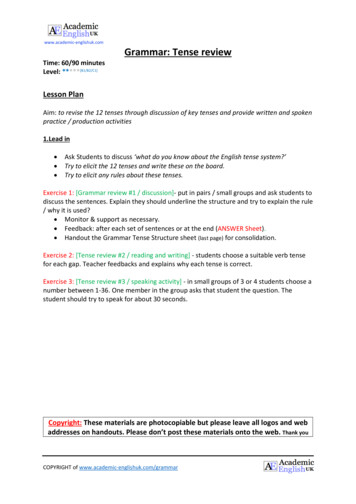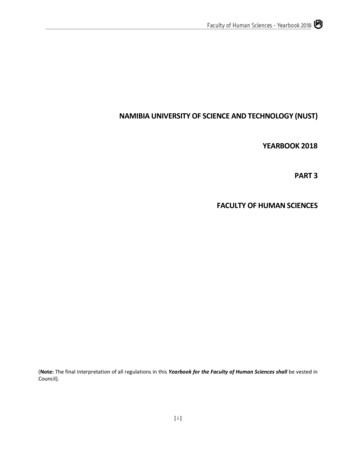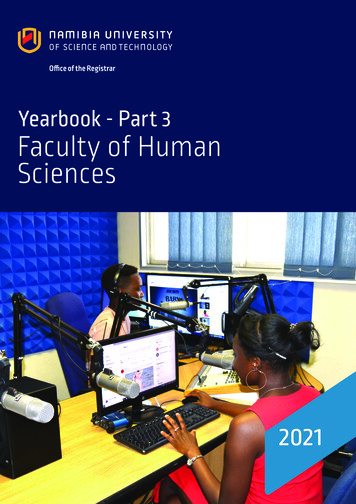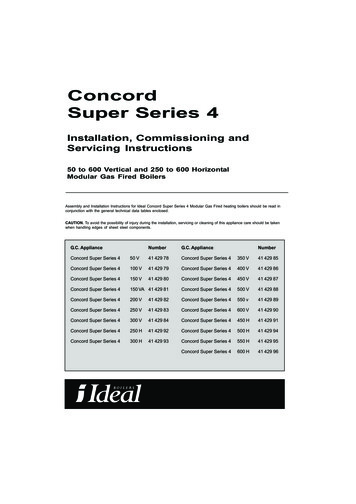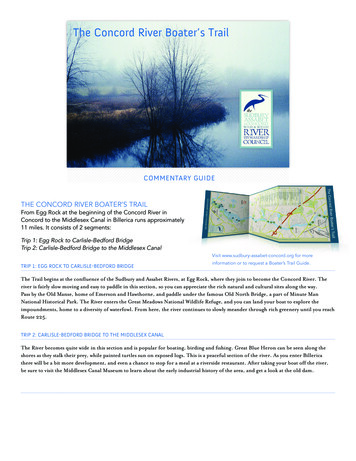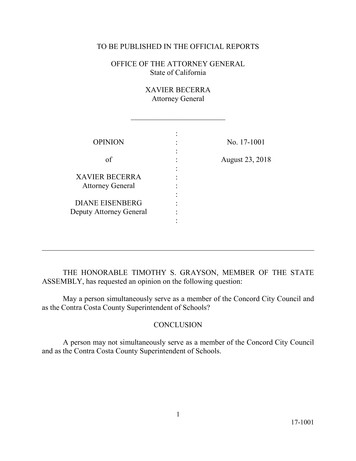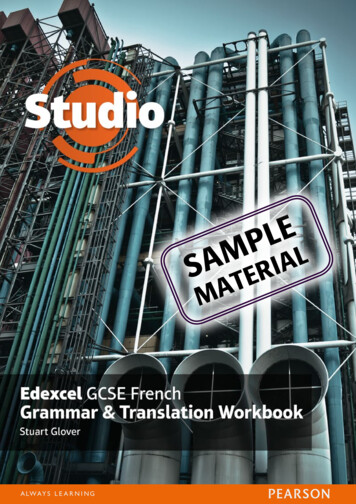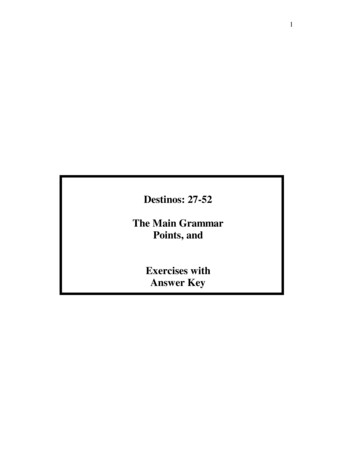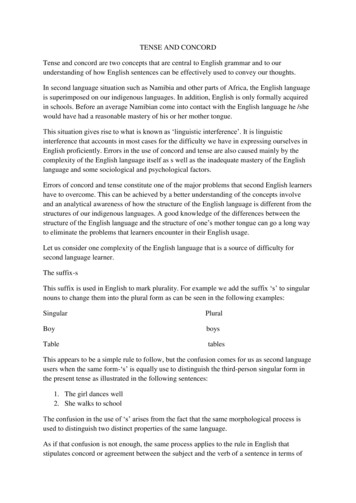
Transcription
TENSE AND CONCORDTense and concord are two concepts that are central to English grammar and to ourunderstanding of how English sentences can be effectively used to convey our thoughts.In second language situation such as Namibia and other parts of Africa, the English languageis superimposed on our indigenous languages. In addition, English is only formally acquiredin schools. Before an average Namibian come into contact with the English language he /shewould have had a reasonable mastery of his or her mother tongue.This situation gives rise to what is known as ‘linguistic interference’. It is linguisticinterference that accounts in most cases for the difficulty we have in expressing ourselves inEnglish proficiently. Errors in the use of concord and tense are also caused mainly by thecomplexity of the English language itself as s well as the inadequate mastery of the Englishlanguage and some sociological and psychological factors.Errors of concord and tense constitute one of the major problems that second English learnershave to overcome. This can be achieved by a better understanding of the concepts involveand an analytical awareness of how the structure of the English language is different from thestructures of our indigenous languages. A good knowledge of the differences between thestructure of the English language and the structure of one’s mother tongue can go a long wayto eliminate the problems that learners encounter in their English usage.Let us consider one complexity of the English language that is a source of difficulty forsecond language learner.The suffix-sThis suffix is used in English to mark plurality. For example we add the suffix ‘s’ to singularnouns to change them into the plural form as can be seen in the following examples:SingularPluralBoyboysTabletablesThis appears to be a simple rule to follow, but the confusion comes for us as second languageusers when the same form-‘s’ is equally use to distinguish the third-person singular form inthe present tense as illustrated in the following sentences:1. The girl dances well2. She walks to schoolThe confusion in the use of ‘s’ arises from the fact that the same morphological process isused to distinguish two distinct properties of the same language.As if that confusion is not enough, the same process applies to the rule in English thatstipulates concord or agreement between the subject and the verb of a sentence in terms of
number- that is singular and plural. This rule further complicates an existing problem in theuse of the suffix ‘s’ especially with the concept of number.Here are some examples of this rule in practice:3. Singulara. The student sleeps soundlyb. The dog barks often4. Plurala. The students sleep soundlyb. The dogs bark oftenNow if we look at the rule governing the pluralisation of nouns as in examples 1 and 2 abovewe would normally have assumed that because the subjects of sentence 3a and 3b are in thesingular, the verbs should not have been marked with the suffix-‘s’ and that the subjects ofthe sentences in 4a and 4b should have been marked instead for plurality but this assumptiondoes not hold because of the nature of English grammar. So for many second language usersthis is a source of difficulty.In addition, the same suffix-‘s’ is also used along with apostrophe to mark possession. Forexample:5.6.7.8.The boy’s shoeThe teachers’ booksAnita’s dressThe students’ forumIn order to overcome the difficulty that comes with this complexity, a second languagelearner has to master the different structural environments in which the suffix-‘s’ functions inEnglish and to learn to use the form appropriately.ConcordThis is a concept that is used in grammatical theory and description to refer to formalrelationships that exist between elements of grammar. In simple terms concord otherwiseknown as agreement simply means that a form of one word requires a corresponding form ofanother. Our sentences in 3 and 4 are examples of how concord or agreement operates inEnglish.There are various kinds of concord in the English language because the principle ofagreement between forms is very central to syntax as the whole point about syntax is theinterrelationships among linguistic structures.Types of Concord1. The Verb ‘to be’-Concord due to some morphological changes that occur in someverbs due to the selection of a particular personal pronoun. In other words, there issome form of agreement between the type of pronoun selected as subject and the formof the verb that goes with it. This relationship is found in the verb ‘to be’.Firstly in the present tense, we have the following morphological changes:
i.The first person singular pronoun-I- must select amThis choice gives us sentences like:9) I am dancingI am happyI am a teacherii.Second Person (singular and plural) pronoun-you- occur with are10) You are dancingYou are happyYou are a princeiii. The third person singular pronouns-he/she/it- select is:11) He is dancingShe is dancingIt is a dogiv.Are is used with the plural personal pronouns-we, they and you as in12) We are dancingYou are dancingThey are dancingIn the past tense, there are two forms of the verb-to be-was and were. Their usage depends onthe type of subject selected. If the subject is singular (no matter whether it is first or thirdperson pronouns) the form ‘was’ is used as in:13) I was dancing.He was a doctor.She was happy.When the subject is plural, the form ‘were, is used regardless of the type of pronoun selectedas subject. Thus:14) We were dancing.They were dancingYou were strangers.What is important for a second language learner of English is to know the types ofsubject that agrees with the different forms of the verb ‘to be’.2. Agreement in terms of number (singular/plural)This type of concord, as illustrated earlier, affects number realisation between the subject andverb of a sentence. This appears to be the most important type of concord in English. Therelationship in this type of concord is as follows:
(i)A singular subject must select a singular verb. The following sentences illustratethis rule:15) The man goes to school.0Salt dissolves quickly in water.A dog barks at night.The bag is open(ii)A plural subject must select a plural verb. The following are examples of this rule:16) The men go to schoolBooks dissolve quickly in fireDogs bark at nightThe bags are open3. Concord Relating to the nature of certain nounsThere are certain nouns which, in actual fact, are singular but typically denote a collection orgroup of individuals. These nouns are singular in form but are plural in meaning and they arereferred to as collective nouns. Examples are: government, people, army, team, staff andcommittee. Nouns of this nature are different from other nouns such as book, table, babybecause these later nouns denote a single entity.The notion of number inherent in collective nouns implies that the concord relation that existsbetween the subject and the verb involves the idea of number rather than the actual presenceof the number marker for that idea. Very often, collective nouns are used as subjects whichselect both a singular and plural verb. For example, both of these sentences are correct:17) The government has failed the electorateThe government have failed the electorate.In the first sentence in 17), the singular verb is used because the noun ‘government, isperceived as a single body, whereas the selection of the plural verb in the second exampleimplies that the noun ‘government’ is used to refer to individuals that make up thegovernment. Other collective nouns with the same notional concord are family, party, group,crew, company.4. Concord between subject and complement of a sentenceThe rule here stipulates that if the subject of a sentence is singular then the complementmust be singular and if it is plural, the complement must be plural. Let us compare thefollowing sentences:18) That man is a prince.Those men are princes.An Elephant is a huge animal.Elephants are huge animals.5. Concord involving the principle of proximity
This type of concord is a source of problem and difficulty for second language learners.The difficulty arises in sentences where some structure comes between the subject and theverb. For examples:19) The lecturer with many national awards was elected president.20) One of the students has been invited to address the press.In both sentences, the subjects-‘lecturer’ and ‘one’ are singular and are, accordingly,followed by singular verbs in spite of the proximity of the plural nouns ‘awards’ and‘students’ to the verbs in the sentences. Here are other examples:21) The behaviour of these ladies is shocking.The register of all the pupils was compiled.The leader of the rioters has surrendered.From these examples, it is apparent that the rule in this kind of sentence construction is that asingular subject followed by a plural modifier will require a singular verb even though theverb may be immediately placed next to a plural noun that is functioning as a post modifier tothe subject of the sentence.A different but related consideration of the rule of proximity involves those cases when twoor more subjects are connected by the coordinating conjunctions ‘or’ / ‘nor’ and aredifferently marked for number as in the following sentences:22) The children or their father is washing the floor.James or his friends are here.Neither the rebels nor their leader has been arrested.In all three examples the subject in the closest proximity to the verb determines the numbermarker for the verb.6. Concord between Determiners and the Nouns they ModifyDeterminers refer to words like, the, his, that, your, several, all, etc. The importantfeature about determiners is that they always must occur with noun, as in:23) The manMany peopleThese individuals
Some determiners also have singular and plural distinctions as veralmostmany.As a result of the singular and plural distinction, when determiners occur with nouns theymust agree in number with the noun that is being modified as in the following examples:24) a. These students.b. This pencilc. All these booksd. All those little assignmentsIn addition, examples (24 c and d) show that two or three determiners can be used to modifya single noun. When this happens, the determiners also have to agree in terms of number. It istherefore necessary to know the order in which the determiners can co-occur with oneanother.DeterminersPreCentralPost-Group IGroup I/AGROUP these/thosefewManymy, your, his, herlittleManyMuchSeveralFirst, second.
DeterminersPre-CentralPost-Group IIIGroup I/BGroup ote: Group I/A determiners exclude each other in a noun phrase. This means no twogroup I determiners can occur together in a noun phrase.In other words, the following constructions are wrong:25) *this your book*the those tablesIn terms of distribution, Group IA determiners are central. This means that they will alwayscome in the middle whenever there are two or three determiners before a noun as in:26) All these other boysHalf your studentsGroup II determiners can modify a noun alone, but they can combine with articles and /orother determiners in GroupI/A and some of them with each other. For examples:27) Both boysThe first boyAll your other tablesSome of the Group II determiners do occur as pre-determiners, while others occur at postdeterminer position. For instance in the first Noun phrase in 26) ‘all’ is used as predeterminer while ‘other’ is used as a post determiner.Group III determiners must be accompanied by an article or another determiner from GroupI/A. For example:28) The only candidate for the examination did not turn up.That same mistake was repeated by him.7. Concord Involving the Personal Pronouns in the Third PersonPronouns refer to a closed set of items which can be used to substitute a noun or a nounphrase as in :
29) If Jane comes today; I will give her the money.In sentence 29), the pronoun ‘her’ has been used in place of Jane.Personal Pronouns are identified as imherusthemHere are examples of their usage:30) He travelled with themI am a teacherWe are cowardsThey Travelled to Zimbabwe.The concord concerning the personal pronouns requires that the third person personalpronouns he, she, it and they must agree with their antecedents both in number and gender asin:31) The students went to University of Ibadan, but they did not visit the zoo.I saw Binta and she gave me the book.Thomas went to school; he was there to submit his assignment.TENSEA proper understanding of tense can be achieved with a good understanding of the verbphrase in English. This is because tense is an element within the auxiliary; and the verbphrase is made up of the auxiliary and the main verb.In addition, tense and the other elements of the auxiliary have a special way of relating to oneanother and to the main verb. These other elements of the auxiliary (apart from tense) aremodal (shall, will, can, may.), the perfective aspect marked by the form of ‘have’ plus thepast participial morpheme ‘en’, and the progressive or continuous aspect marked by the formof ‘be’, plus the present participial morpheme ‘ing’. Of all the elements that constitute the
auxiliary in English only tense is obligatory, the others-modal, perfective and progressiveaspectual markers are optional.Three basic tenses are identified in English grammar but technically, tense in English is eitherpresent or past. The three basic tenses are the present, the past and the future.The present tense is used of:a) States that are permanent or likely to remain as they are for an indefinite period oftime. For examples:1) The world is roundThe earth goes round the sun.b) Habitual actions as in:2) She goes to Cape town every monthThe people celebrate this festival once in a year.The past tense is generally used of actions or events which took place, and were completedin the past. Examples are:3) Agnes took the book last weekI was in Maerua Mall yesterday.The future tense is used of actions occurring during the future time as in:4) My brother will buy a car next month.I will sew the cloth tomorrow.However, tense in English is strictly grammatical. Although certain time references aretypically conveyed by particular tenses, the time references of such tenses are not restricted tothose typical ones. For instance, even though the past tense typically expresses action thattook place in the past, it often also expresses future or present action. For example:5) If I were you I would not agree.This example is marked formally for the past tense but it is used hypothetically to expresspresent action.The ModalsThis is an optional element of the auxiliary. It is not so much concerned with time as withsuch things as possibility, ability, obligation and condition. However, the form ‘will’ and‘shall’ are sometimes used to refer to the future time.The modals occur only in the first element of the verb phrase and only at initial position. As aresult, they cannot combine with each other nor can they change positions when combinedwith other elements of the auxiliary (the perfective and the progressive aspects). The verbfollowing a modal is also not inflected for any form at all. For example:6) I will go to school
I can play lawn tennis.She must dance to the tune.Michael may come to church on Sunday.He ought to do the job.The AspectsAs explained earlier, aspect can be either perfective or progressive. The perfective aspectgives us the perfective tense which can either be present or past. That is present perfect tenseor past perfect tense.The present perfect tense is most commonly used to describe actions or situations whichstarted in the past, have continued to the present, and may still be continuing. For example:7) My parents have been married for 53 years.This means that my parents were married sometime in the past they are still married now andwill/may stay married. In the example below;8) She has been a nurse since she was eighteenmeans the person referred to became a nurse at eighteen and is still a nurse now and maycontinue to be a nurse.In addition, the present perfect tense is used to refer to actions or events which took place inthe past, but whose consequences are still being felt. This usage can be seen in the followingexample:9) Since nine eleven, the world has known no peace.The important thing to note is not when or where the events or actions took place, but the factthat they have taken place.The Past perfect tense is commonly used to refer to actions or events that took place, orsituations that existed, before some other period of past time. For example:10) He had already left the meeting when the chairman collapsed.The car had not been sold when I went to the garage yesterday.The main point in these two sentences is that two actions took place in the past but one tookplace before the other.The progressive or the continuous aspect gives us the progressive tense which also can bepresent or past.The present progressive is commonly used to describe present actions or events which areonly temporary. For example:11) We are producing Romeo and Juliet this year.
Secondly, the present progressive may describe actions or events which are actuallytaking place at the present time. Thus:12) I am giving a lecture now.The past progressive refers to past actions or events which were temporary or actions orevents which actually were taking place at some point in the past. For example:13) Literature students were reading Romeo and Juliet for the West African SchoolCertificate Examination in the late 19702Africans were killing twins in the sixteenth century.The first sentence in 13) expresses a past event which was temporary while the secondsentence expresses an event which actually was taking place in the sixteenth century.There is a sequence of relationship between tense and other elements of the auxiliary. That ismodal and aspect. This relationship can be explained using the following sentences:14) She could have been dancing.In this sentence we have all the elements of the auxiliary present. That is, there is acombination of tense, modal, and the perfective and the progressive aspects. When thisoccurs, the modal precedes the other two aspects-have en and be ing. In addition, thetense is attached to the first verb element in the sequence, in this case the modal.15) He has been playing the piano.These examples show that the auxiliary may contain both elements within the aspect (have en and be ing). When both pairs are present, the perfective aspect comes before theprogressive one and the tense affects the first element of the auxiliary in which case it willaffect ‘have’.16) She has stolen the bag17) They were cooking rice.Sentences (16 and 17) show that an auxiliary may contain one of the elements of aspect.When this happens, the tense will affect only the first element of the auxiliary in which case itwill be ‘have’ if it is perfective as in 16) and ‘be’ if it is progressive as in 17).18) I cooked rice last SundayThis sentence shows that none of the auxiliary elements is present except tense.The important point to note is that the first verbal element in the sequences has tense attachedto it, regardless of which element it is. For instance, depending on the sequences as shown inour examples, tense will be attached to modal as in 14) in others ‘have’ as in 15) and 16) or‘be’ as in 17) and in18) the tense is attached to the verb because the other elements of theauxiliary are not present.
The examples we have illustrated above, show that most of the errors of tense that secondlanguage learners of English make are due to the violation of this sequence in theconstruction of sentences.
another. Our sentences in 3 and 4 are examples of how concord or agreement operates in English. There are various kinds of concord in the English language because the principle of agreement between forms is very central to syntax as the whole point about syntax is the interrelationships among linguistic structures. Types of Concord 1.


